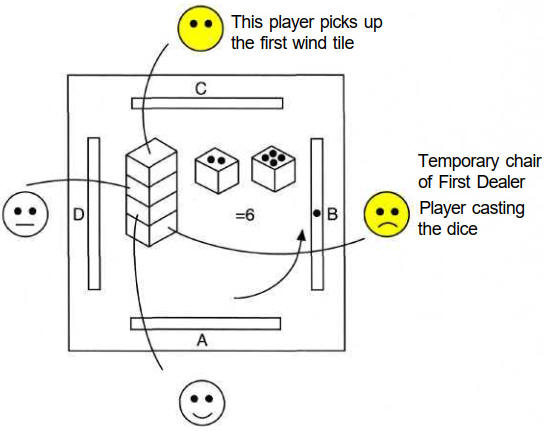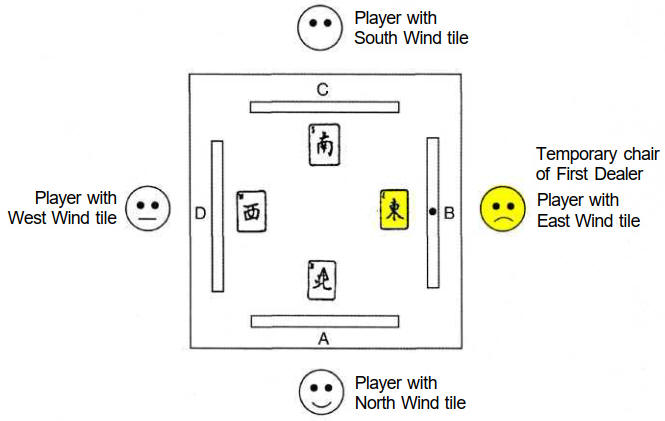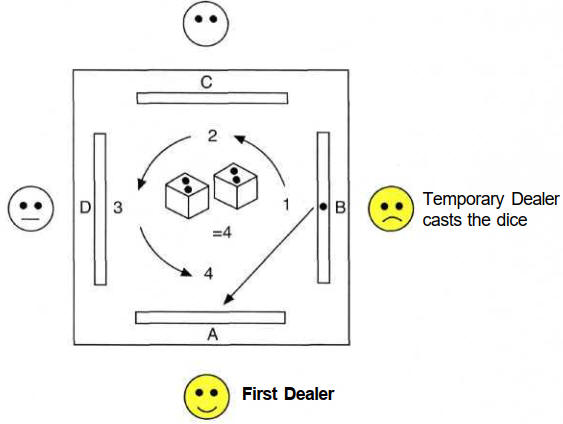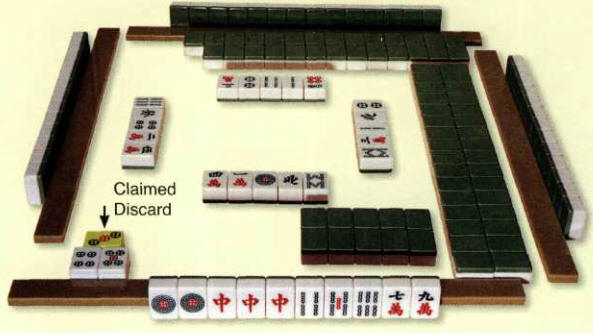
16-Tile Game (Taiwanese Game)
Jeux
Mah-Jongg
Another variation of the 13-Tile Game is the 16-Tile Game, in which each
player draws 16 tiles instead of 13. The game is basically the same as the
13-Tile game but with an extra matched set. Also, the method of scoring and seat
allocation is different.
Seat Allocation (Ban Wei)
Once the
four players have been seated randomly around a square table, one player casts
two dice, and the dots are summed. Counting the dice caster as 1, the players
are counted counterclockwise until the sum is reached at the position of the
chair of the Temporary First Dealer.
Example:
If the player at Side A of the table casts the dice and the sum of the dots is two, then Side B is the chair of the Temporary First Dealer. Accordingly, the ruler bearing the Dealer's ensign is placed at Side B.

Following this, any player picks out four different Wind tiles, puts them face down on the table, mixes them well, and stacks the tiles in the center of the table.
The player who sits at the Temporary Dealer's chair casts two dice again. Again the dots are summed and the players are counted counterclockwise, with the Temporary Dealer being counted as 1 until the sum is reached.
The player who is counted last picks up the top tile from the Wind tile
stack. The player on his or her right picks up the second tile, followed by the
other players in counterclockwise fashion.
Example: The player sitting at
the Temporary Dealer's chair (Side B of the table) casts the dice and the total
number is 6. The player at Side C picks up the first tile. Players D, A, and
then B, in turn, pick up their tiles.

The player who picks up the East Wind tile is the Temporary Dealer and will be seated at the Temporary Dealer's chair (Side B of the table), as determined by the first dice cast.
Each of the other players will also be seated at the appropriate seat according to his or her Wind tile.

Building the Walls
After all the players have been seated according to their Wind tiles, they all take part in turning the tiles face down, including the 8 Flower tiles, and mixing them thoroughly. Each player then lines up two single rows of 18 tiles each (similar to the Shanghai Game).
Designating the First Dealer, Breaking the Walls, Revealing Flower Tiles, and Drawing Make-up Tiles The Temporary Dealer casts two dice again and totals the dots.
Beginning with the Temporary Dealer, who is counted as 1, the players are counted counterclockwise until the sum is reached.
The player who is counted last becomes the First Dealer of the game. The ruler with the Dealer's ensign is, accordingly, placed at his or her side of the table. Next, the wall of tiles on the First Dealer's side is broken.
Counting the tiles of this wall from right to left, the First Dealer saves a number of stacks equal to the last sum of the dots on the dice.
He or she separates these stacks from the rest and keeps them to the right.
The dealer then begins to draw, two pairs at a time. Others follow in a clockwise direction until each player has drawn four times for a total of 16 tiles. The Dealer then draws an additional tile as his or her first draw.
After the initial drawing is complete, all the players display the Flower tiles on the table from the initial drawing. Beginning with the First Dealer, each player draws one make-up tile from the end of the wall, for each Flower tile revealed.
If the make-up tile happens to be another Flower tile, the player must wait until all the other players have drawn their make-up tiles before he or she can draw another make-up tile.
The game can now begin, with the First Dealer discarding a tile.

Shuh
When a player claims a discard from
his or her Upper House to match a Sequence, the player must place the claimed
tile in the middle of the set, face up, in front of him or her.


Garng
When a player declares a concealed
Garng or Quadruplet, he or she displays the Quadruplet face down and should not
reveal the tiles to the other players.

Winners
A player can complete a hand by
drawing the Winning Tile from the walls during his or her turn, or by claiming
the Winning Tile when another player discards a tile or declares a revealed
Garng.
If a player fails to claim the Winning Tile when it is first discarded by a player, however, he or she cannot claim the Winning Tile discarded by other players until after making a discard. Even if the player draws a Winning Tile from the walls, he or she still cannot win until after a discard has been made.
If a discarded tile is claimed by more than one player to
complete the hand, there will be more than one winner. Only the discarder pays
all the winners.
Scoring
Scores are counted in terms of Tai
instead of Fan and the total score is multiplied by the sum of Tai plus a fixed
value called De for the completion of the hand. In general, the value of De is 2
to 4 times that of each Tai.
BONUS TAI
Whenever the Dealer
wins, the discarder pays him or her one extra Tai as a bonus.
When the Dealer draws the Winning Tile, each of the other players pays the dealer one extra Tai as bonus.
When the Dealer discards the Winning Tile, he or she pays one bonus Tai to the winner.
When the Dealer repeats as Dealer again, two Tais are added as a bonus for each repetition.
| ONE TAI Hua WuHua Tsu WuTsu Tsu Mor Ming Garng Chiang Garng Hai Dee Men Ching |
Each Flower tile earns a Tai. Absence of Flower tile. Each Triplet of Honor tiles earns a Tai. Absence of Honor tile. Self-drawn Winning Tile. Each revealed Quadruplet set. Robbing a Garng. Last tile on the table self-drawn by the winner. No revealed tile. |
| TWO TAIS An Garng Duh Ting Liang An Kan |
Each concealed Quadruplet set. The only tile to win, which is a Bridge tile or the tile that matches the eye. Two concealed Triplets. |
| THREE TAIS Wu Tsu Hua Men Ching Bu Chiu Xiao Ping Hu |
Absence of both Flower and Honor tiles. Self-drawn Winning Tile of a non revealed hand. All Sequence Hand mixed with either the Flower or Honor tiles (as the eye of the winning hand), or both. |
| FIVE TAIS San An Ka Shuh Tsu Wai Long Wei Wei |
Three concealed Triplets. The winning hand is completed when more than 5, but less than 10, discarded tiles are on the table. An External Dragon suit, that is, a complete set of numbers, from 1 to 9, of the same suit, found in both concealed and revealed tiles. Two Triplets plus one pair of Wind tiles |
| TEN TAIS Huen Yi Sher Dui Dui Hu Nei Long Dar Ping Hu Chuan Ghiu Ren Ooh Tsu |
Mixed One-Suit Hand. All Triplets Hand. An Internal Dragon suit, that is, a complete set of numbers, from 1 to 9 of the same suit, all found in concealed tiles. All Sequence Hand with the absence of both the Flower and Honor tiles. All Revealed Hand with the Winning Tile self-drawn or claimed. A winning hand completed when only five, or fewer, discarded tiles are on the table. |
| FIFTEEN
TAIS Xiao San Yuan Bao Ting |
Junior 3 Chiefs, that is, two Triplets plus one pair of Dragon tiles. After drawing the 16 tiles from the wall and before drawing or claiming any tile, a player announces that he or she has a Ready Hand and is calling for the Winning Tile. Note: After the announcement, the player may not exchange any tile in the hand or he or she will forfeit the status of Bao Ting. |
| San Fung Szu An Kan |
Three Triplets
of Wind tiles. Four concealed Triplets (a Quadruplet is counted as one concealed Triplet). |
| TWENTY TAIS Chi Chiang Yi |
A player who has seven Flower tiles can claim the eighth flower tile from another player. |
| THIRTY TAIS Bar Tsu Hua Xiao Szu Xi Dar San Yuan Ni Gu Ni Gu |
Eight Flower tiles. Junior 4 Happiness, that is, three Triplets plus one pair of Wind tiles. Grand 3 Chiefs, that is, three Triplets of Dragon tiles. Seven pairs plus one Triplet (a Quadruplet is counted as two pairs, and must be kept in the playing hand without declaring Garng). |
| FORTY TAIS Dar Szu Xi Ching Yi Shei Tian Hu DeeHu Wu An Kan |
Grand 4 Happiness, that is, four Triplets of Wind tiles Pure One-Suit Hand. Heavenly Hand, that is, the Dealer wins on the first draw. Earthly Hand, that is, the Winning Tile is the first discard by the Dealer. Five concealed Triplets. Note: A Garng is also counted as a concealed Triplet. |
